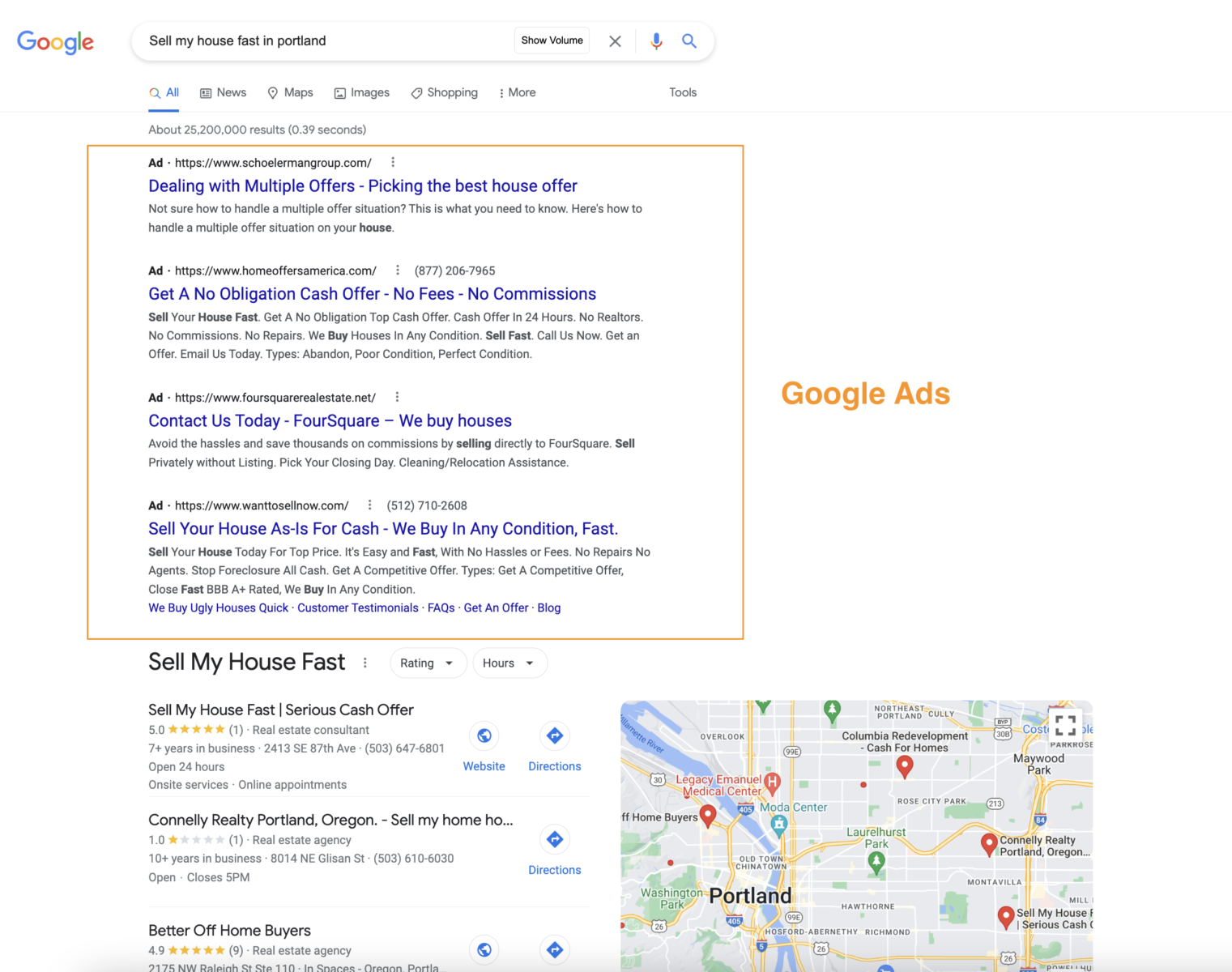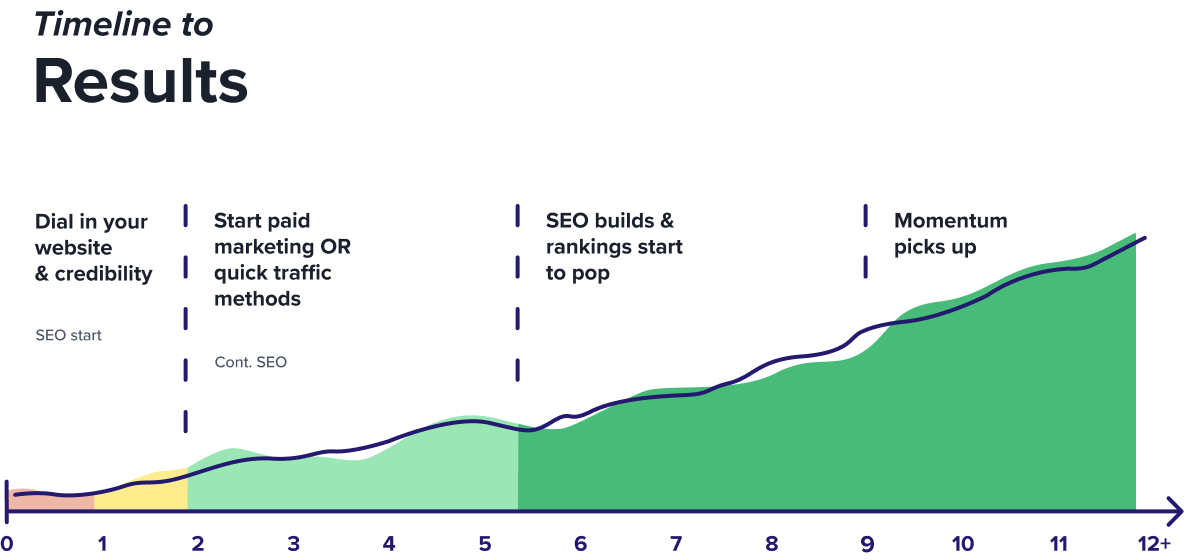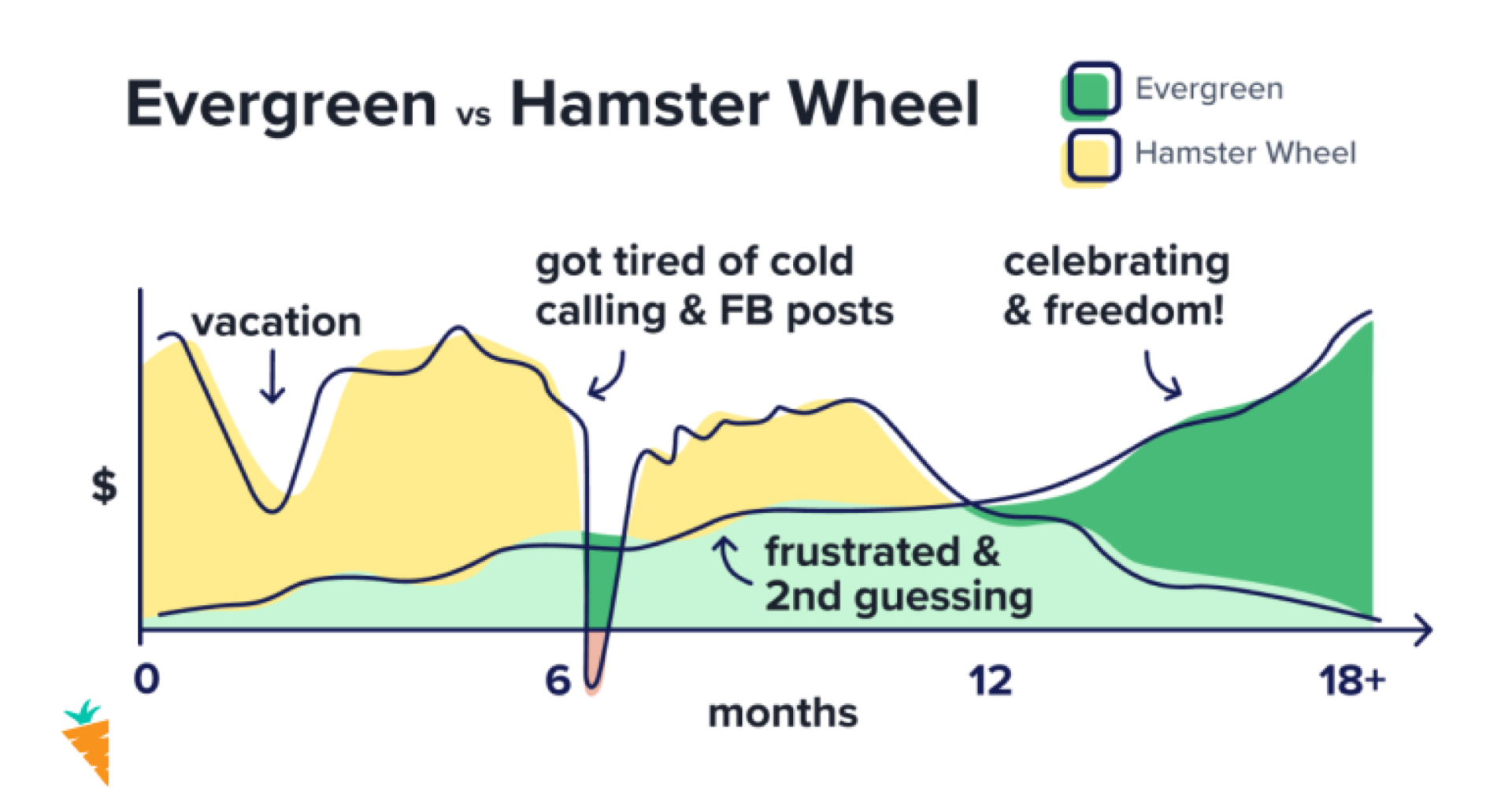
After spending over a million dollars on ads over 12 months and reviewing dozens and dozens of accounts, we’d like to share our findings on which platforms are giving investors the best bang for their buck.

Demo Carrot: How many deals are you losing to your competitor’s website?
Take a Free DemoAt Carrot, we’ve helped tens of thousands of real estate investors generate millions of motivated seller leads — through evergreen marketing and our holistic lead generation hub.
Brandon Bateman has done a scaled version of this but in the paid advertising realm. Specifically, he spent millions of dollars in Google and Facebook ad spend for his real estate investor clients over 2021 to generate leads and land deals.
For this guide, our team collaborated with Brandon to comprehensively compare SEO vs. Google Ads vs. Facebook Ads for real estate investors trying to find motivated sellers.
We’re going to look at the pros and cons of each channel. Then we will compare the average cost per lead, deal size, and conversion rate of each channel. And finally, we’ll give you the ultimate real estate investor marketing roadmap for creating synergy between all three marketing methods to scale your business systematically.
Let’s dive in.
Facebook Ads Pros & Cons
Facebook Ads are probably the most popular type of advertisement that real estate investors leverage. You can use Facebook Ads to either target a brand new audience or retarget people who’ve already visited your website.
The most significant upside to Facebook Ads is that they’re pretty easy to set up, allowing you to access a broad audience. The biggest downside is that Facebook advertising is a form of interruption marketing, meaning that people are on the platform for something else when your ad interrupts them. That doesn’t mean it’s ineffective… but it’s something every advertiser needs to keep in mind.
Pros:
Advertise Across Multiple Platforms
Facebook Ads allow you to target your ads to specific people on Facebook, Instagram, and Audience Network. and Messenger. So you have a very expansive reach and can show your ads wherever people prefer to hang out.
Detailed Targeting & Retargeting
Facebook Ads also offer detailed targeting options. You can target people based on their interests, demographics, behaviors, and purchasing history. And you can also retarget people who have visited your website or engaged with your Facebook page.
Resources like FB Ads Library, allow advertisers to view and analyze other ads running on the platform. This feature enables them to gain insights into successful ad campaigns within their niche, helping them refine their own strategies for even greater effectiveness. So you can laser-focus your advertising to reach only the most relevant people.
User Friendly
Facebook Ads are very user-friendly. The creation process is simple, and you can get your ads up and running quickly.
Cons:
Lack of Knowledge Means Wasted Money
The biggest downside of Facebook Ads is that many real estate investors don’t know how to use them effectively, so they end up wasting a lot of money on ads that don’t reach their target audience.
Strict Facebook Advertising Policies
Facebook also has very strict advertising policies. If you violate their policies, your account can be shut down, and you end up in “Facebook jail” for quite some time before you can rerun ads.
Some of Facebook’s advertising policies include…
- No Misrepresentation
- Ads must not contain false, deceptive, or misleading content, including deceptive claims, offers, or business practices.
- No Discrimination
- Ads must not discriminate against people based on race, ethnicity, national origin, religion, gender, age, disability, or sexual orientation.
- No Controversial Content
- Ads must not contain content that is inappropriate, offensive, or controversial. This includes ads for adult products or services, firearms, tobacco products, and political or religious content.
Of course, Facebook ultimately determines whether your ads are appropriate, which can be a bit problematic in its ambiguity.
Facebook Ads Are Interruption Marketing
Facebook Ads is interruption marketing. People are in the middle of doing something else when your ad pops up and interrupts them. So there’s a high chance that they will ignore it. That’s just the nature of interruption marketing.
Google Ads Pros & Cons
Google Ads is another powerful advertising platform for real estate investors. One of the best parts about Google advertising is that it’s not the same type of interruption marketing as Facebook Ads — because of the nature of the platform, people are searching for whatever your ad is promoting… so long as your keyword targeting is laser-focused.
The most difficult part about Google Ads is getting the keyword targeting where you want it — this can take hours of research and testing.
Pros
Google Ads Results Can Be Instant
When you create a Google ad, it goes live almost immediately. So you can start seeing results (or leads) very quickly. SEO takes much longer to see results.
Easy to Create Campaigns
Google Ads are also straightforward to create campaigns. The creation process is simple, and you can get your ads up and running quickly. Do keyword research, set your budget, and create a campaign.
Great Exposure in Search Results
Google Ads are also very effective at getting your business exposure on search engine results pages (SERPs). Your ad will appear as a sponsored link above the organic search results for your targeted keywords.
Google Ads Have Increased in Size
Google Ads have also been increasing in size over the past few years. So they’re taking up more real estate on the SERP… which means your ads can be more persuasive!

Testing & Optimization Options
Google Ads also offers a lot of testing and optimization options. You can test different ad copy, landing pages, bids, and other settings to see which combinations work best.
Budget Flexibility
Google Ads also offers a lot of budget flexibility. You can set your budget (big or small) to be per day, month, or click. So you can find a budget that works for you.
Cons
You Pay Per Click
One downside of Google Ads is that you pay per click. So even if someone doesn’t convert into a lead or sale, you still have to pay for that click.
Competitive Markets Have High Cost Per Click
If your market is competitive, the cost per click for your targeted keywords will be high. So you’ll need to have a larger budget to compete.
No Budget = No Leads
Another downside of Google Ads is that you need to have a budget to get leads. If you don’t have any money set aside for your marketing efforts, then you can’t use Google Ads. The same is true for Facebook Ads. When you stop the ads, traffic, and leads stop coming in.
Need To Have Laser-Focused Keyword Targeting
Google Ads also require laser-focused keyword targeting. Your ads won’t be effective if you’re not targeting the right keywords.
Steep Learning Curve
Google Ads has a bit of a steep learning curve. It takes some time to learn how to use them effectively — it can be a big investment to learn enough to run effective Google Ads.
Requires Excellent Landing Pages
Google Ads also require excellent landing pages. If your landing pages are not up to par, you will not see good results from your ads.
SEO Pros & Cons
For longevity, SEO is the most powerful marketing method available to real estate investors. Rather than depending on interruption marketing, you meet motivated sellers where they are — when they are looking for something in Google, you provide the answers. And as opposed to Google Ads, you do so organically without depending on a big marketing budget to put coal in the fire.
And once you’ve achieved high rankings for high-value keyword phrases in your market, you’ll likely stay in that position for years to come, creating a sustainable and predictable lead flow for your business.
The downside to SEO is that it takes an upfront commitment to produce content and typically requires three months to 6 months to start seeing results.
Pros
Sustainable Lead Flow
One of the biggest benefits of SEO is that it creates sustainable lead flow. Unlike methods like Google Ads, where you have to keep paying to get leads, with SEO, your leads will continue to come in as long as you rank in the search engines.
Longevity
SEO is also the most long-term marketing method available. Once you’ve achieved high rankings for your targeted keywords, you’ll likely stay in that position for years to come, creating a consistent and predictable lead flow for your business.
High-Quality Leads
SEO also generates high-quality leads. People who find you through organic search are already interested in what you have to offer — they’re farther down the sales funnel than people who come from other marketing methods.
Cons
Takes Time to Rank
One downside of SEO is that ranking in search engines takes time. It typically takes three to six months to start seeing results.
Requires Consistent Content Production
To rank in the search engines, you must consistently produce high-quality content. If you slack off on your content production, your rankings will drop.
Requires Good Website Tech Stack
To SEO effectively, you need a good website tech stack. This means your website needs to be well-coded, have a fast loading time, and be mobile-friendly.
Average Cost Per Lead By Channel
Here’s the average cost per lead for real estate investors on each channel — these stats are taken straight from Bateman’s research.
Median Cost Per Lead: $132
Average Cost Per Lead: $103
Median Cost Per Lead: $279
Average Cost Per Lead: $206
(We also pulled data from 30 different Google Ads accounts amounting to over $1.2 million in spending. Our accounts averaged a $196.25 cost per lead in 2021)
SEO
This is a bit different because you’re not directly paying to get SEO rankings. You could reasonably not pay a penny and get leads and deals through SEO. Or you might pay a little bit — like through Carrot — to help with your website tech stack, consistent content production, and search engine optimization and pay around $100 per month to end up generating 30-100 leads per month entirely through SEO, for which the average close rate is about 1 in 10 or 1 in 15.
Average Deal Size by Channel
One metric that real estate investors forget to consider is the size of the deals they’re doing through each channel. Because believe it or not, different channels generate different quality of leads and, therefore, different quality of deals.
Brandon says his clients typically do 10% to 40% bigger deals through digital marketing than physical marketing.
Facebook: Facebook leads are less motivated but more likely to be exclusive, which often means they are the biggest deal size for our clients.
Google: Google leads are more motivated, but also more competitive. In heavy competition markets, deal sizes can be lower due to the various levels of negotiations.
SEO: SEO deal sizes generally follow the same trend as PPC in terms of deal size.
Average Lead Conversion By Channel
The average lead conversion rate is the percentage of leads that turn into deals.
This number will differ for every real estate investor. Still, SEO almost always has a higher lead conversion rate than Google Ads or Facebook Ads because it’s entirely organic — that is, people, coming looking for you… so they’re more motivated.
Google Ads typically have a higher conversion rate than Facebook Ads for the same reason — because you’re simply advertising to people who are typing specific keywords into Google.
Here are some benchmarks…
- Facebook: 20-30 leads per deal.
- Google: 10-15 leads per deal.
- SEO: 10 leads per deal.
But remember: 99% of your leads are NOT going to turn into deals after just a single point of contact — that’s why it’s so important to have an excellent follow-up process. You can learn more about how to follow up with leads effectively here.
The Ultimate Real Estate Investors Marketing Roadmap
Here’s a quick overview of what your real estate marketing mix should look like.
First, understand that if you invest in it starting now, SEO can make growing your business 1000x easier and more sustainable. So work on your website’s SEO and optimization rate from the get-go. After six months to a year of optimization, you’ll see consistent results from your efforts. If you don’t know where to start, go here.

Second, while you’re building the SEO arm of your business, it’s important to use other advertising and marketing tactics to keep the lead-flow momentum going. This includes direct mail, Facebook advertising, Google advertising, door knocking, cold calling, and many other tactics.
Do what you must to find leads while waiting to claim your SERP rankings.
At some point, the evergreen marketing arm of your business will take over the advertising arm, and you’ll be well on your way to lead-flow freedom.

We’ve seen many real estate investors achieve true freedom in their businesses by transitioning from what we call “Hamster Wheel Marketing” — the moment you get off the wheel leads stop flowing — to “Evergreen Marketing” — it keeps growing even when you’re not actively working on it.
Go here to learn more about this marketing map.
Conclusion
So there you have it: A detailed comparison of SEO vs. Google Ads vs. Facebook Ads for real estate investors. As you can see, each has its benefits and drawbacks. And each should be used at different stages in the lead generation process.
But if we had to pick the best method for real estate investors, it would be SEO. Why? Because once you rank for your target keywords, the leads will keep coming in month after month with little to no effort on your part. That’s the power of evergreen marketing.
If you’re just getting started, though, focus on generating leads through all channels — Facebook Ads, Google Ads, direct mail, door knocking, cold calling, etc. — while working on your SEO.
And if you need help getting started, we have a free guide that will teach you everything you need about real estate marketing.
Thanks for reading!